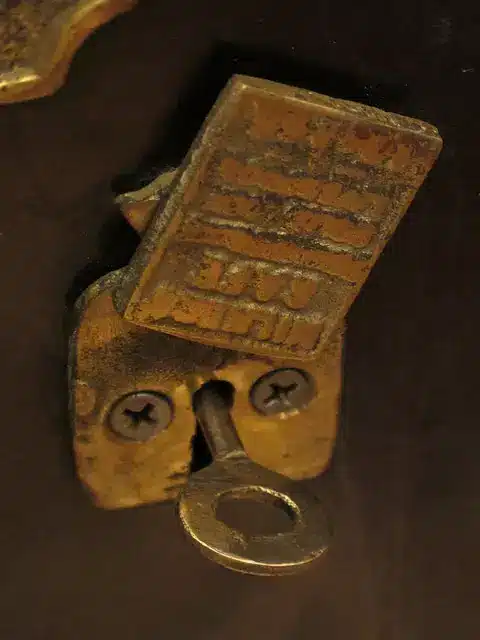 Exploring Lock and Key History: From Ancient to Modern
Exploring Lock and Key History: From Ancient to Modern

People often don’t think twice about locks and keys. These days they are just part of everyday life. But have you ever considered where they originated? Lock and key history stretches back thousands of years – it’s a fascinating journey through ingenuity and craftsmanship.
Imagine a time before mass production, when everything was painstakingly made by hand. This includes the early locks, often crafted from wood, and surprisingly effective. One early example, the Egyptian pin lock, reminds us of the ingenuity of our ancestors.
Table of Contents:
Ancient Origins – Lock and key history
The earliest evidence of locks comes from ancient ruins – picture archaeological digs revealing remnants of civilizations long gone. We’re talking about places like ancient Assyria, where a lock over six thousand years old has been discovered. Think about that for a second – it’s older than the pyramids of Egypt.
Early Mechanisms – The Egyptian Pin Lock
This early lock involved a system of wooden pins within the lock body. The correct key, when inserted, would lift these pins, allowing the horizontal bolt to move and the lock to open.
The fascinating thing is, this basic principle, refined over time, still underpins some of the locks we use even today. Just think, the lock on your front door could have a connection to ancient Egypt. This early lock, while simple, was a leap forward in securing valuables.
Roman Innovations
Now fast forward a few centuries to the Roman Empire. The Romans, with their impressive engineering skills, brought significant innovations to lock and key history. They adopted the Egyptian pin lock idea and introduced metal, crafting locks that were more intricate and secure.
Affluent Romans used these metal locks to protect valuables kept in their households. Many of these locks were intricate and more secure, reflecting the craftsmanship of the time. The Romans introduced metal to lock designs, marking a significant step in lock and key history.
You know how we carry keys on our keychains today? The Romans had a different and perhaps more fashionable approach. They wore their keys on their fingers – talk about keeping your valuables close at hand. It served a dual purpose: securing their belongings and flaunting their status. Only the wealthy could afford such elaborate keys and the valuables they protected. They remind us that even back then, security and status often went hand in hand.
Medieval Times and Beyond – Lock and key history
Over time, locks evolved. Take the medieval era, for example, especially from the 14th to the 18th century. During this period, warded locks became more prominent. These locks featured a series of wards, or obstructions, inside the lock body.
Only a key with the correct shape could navigate these wards and engage the bolt. We see examples of beautifully ornate locks gracing homes, churches, and other buildings. Some even bear fanciful names like the “Drunk Man’s Lock,” hinting at their intricate designs and maybe even a good dose of medieval humour.
The Industrial Revolution – A Turning Point
The late 18th century saw the dawn of the Industrial Revolution, a game-changer for lock and key history. Manufacturing processes improved rapidly. This led to the mass production of more complex and sophisticated locks. Mechanical locks started to emerge during this era.
Names like Robert Barron, Jeremiah Chubb, and Linus Yale Sr. became synonymous with key innovations during this era. These inventors and problem-solvers revolutionised how we think about locks. Their work laid the foundation for many modern lock designs – pretty incredible when you think about it.
| Inventor | Innovation | Impact |
|---|---|---|
| Robert Barron | Lever tumbler lock | Significantly increased lock security, making them much harder to pick. |
| Jeremiah Chubb | Detector lock | Featured an ingenious mechanism that would “detect” if tampering had occurred, adding an extra layer of security. |
| Linus Yale Sr. | Pin tumbler locks | Revolutionized lock design, forming the basis for many of the locks we use today. |
We’re talking about advancements like the lever tumbler lock and the pin tumbler lock. It’s around this time that safes – designed for even greater security – entered the scene, produced by companies like Chubb, a name still recognised in the industry today. These safes often incorporated advanced locking mechanisms, making them highly resistant to break-ins. The development of the Chubb detector lock is a testament to the ingenuity of lockmakers during this period.
Lock and key history – Beyond the Mechanical
The 20th century ushered in a new era in lock technology. No longer confined to purely mechanical systems, we saw the rise of electromechanical and electronic locks. This period marked a shift from the traditional, large wooden keys to smaller, flat keys that were more convenient to carry.
The Digital Age – From Keycards to Smart Locks
Think keycard locks in hotels – those were some of the early adopters. Electronic locks offered keyless entry and often connected to sophisticated access control systems, upping security. Now, fast forward to the present day, and we see these technologies used in homes and businesses globally. From keypads to smartphone-controlled smart locks, lock and key history shows us how these technologies constantly evolve.
As technology progresses, so do the capabilities – and challenges – of lock technology. For instance, the rise of bump keys and other sophisticated lock-picking techniques has kept lock manufacturers on their toes. They’ve had to constantly innovate, incorporating things like serrated edges on keys and more complex tumbler arrangements within the locks themselves. It’ll be interesting to see where the journey takes us next.
Conclusion
Looking back at lock and key history gives us a new perspective, don’t you think? What we often take for granted has a long and intricate history of human ingenuity, constantly pushing to make things safer and more secure. From simple wooden mechanisms to complex digital systems, it’s remarkable how this evolution reflects our desire for security in an ever-changing world. The history of locks and keys is a testament to our constant drive to keep our possessions safe.


